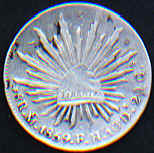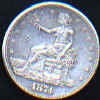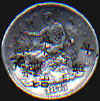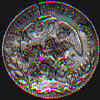Chopmarked Coins of
the Late 19th & Early 
20th Century
During the late 19th and early 20th century a wider variety of foreign silver coins circulated in China than at any other time since their introduction in the 16th century. This was due both to the increased presence of foreign powers in China and the growing number of issuers whose coinage was circulated and accepted as a medium of exchange.
The legitimacy of foreign silver coins and their importance in Chinese
commerce was secured and reinforced following the end of the Opium War
(1840-1842). Succumbing to both military and political pressure from Great
Britain, France, Germany, America, Japan and other countries, the Ching
imperial government was forced to open major harbors along the coast line
and waterways as treaty ports, and to cede land to those countries as foreign
concessions. In the decades following the Opium War, international trade
flourished in these extraterritorial regions. The merchants and
adventurers from abroad were soon joined by foreign banks,
and the result in the growth in trade was that numerous amount of foreign
silver coins arrived and circulated in the Chinese market without any
difficulty.
Among those foreign silver coins, the most popular were:
Spanish Colonial Mexican Dollars
During the mid18th to early 19th centuries Spanish colonial Mexican dollars, including Pillar Dollar (1732-1772) and Portrait Dollar (1772-1821), constituted a major part of China bound cargoes. These dollars became an increasingly important part of China's currency market and were by far the most widely accepted of all the foreign silver coins circulating, particularly in southern China. Although Mexico declared independence from Spain in 1821, and the production of Spanish colonial Mexican Dollars ceased from that date, by that time these coins had already been recognized by the business community as "Principal Money", and served as a basis for bookkeeping and an exchange medium for all types of commercial activities. Such a close tie between those coins and the Chinese was not easily broken, and even late in the 19th century, Spanish colonial Mexican Dollars were still preferred by the Chinese and represented a significant share of all circulating coinage.
Spanish colonial Mexican dollars, including Pillar Dollar (1732-1771) and Portrait Dollar (1772-1821), had been one of the major occupants in the China bound cargoes, and a dominant players above all the foreign silver coins who won an important share of the China's currency market. Although, in 1821, Mexico declared independence from Spain, and since then, the Spanish colonial Mexican Dollars ceased producing and the supply discontinued, however, these coins had already been granted for a long time the position of "Principal Money", being the base money for bookkeeping and an exchange media for business activities of all kinds by the commercial society. Such a close tie between those coins and the Chinese was not easily broken down, even late in the end of the 19th century, Spanish colonial Mexican Dollars were still a preference to the Chinese and occupied a significant market share in China.
Mexican Eagle Dollars
As the supply of new Spanish colonial Mexican Dollars ended and the existing coinage in circulation could not meet the growing Chinese demand for silver, it was just a matter of time before a replacement became necessary. This action was formally taken in the 6th day, 2nd month, of 1856, when the monetary business association of Shanghai formally decided to replace the colonial dollars with the Mexican Eagle Dollars as the unit of "Principal Money". This decision was quickly accepted by the major foreign powers conducting business in China and who had been waiting for over 30 years for a resolution to the monetary chaos.
Other Foreign Trade Dollars
In the 2nd half of the 1800's, while Mexican Eagle Dollars were circulating in rapidly growing numbers and old colonial Mexican Dollars were gradually fading from the market, a number of other coins were introduced, including Hong Kong Dollars (1866-1868), British Trade Dollars, French Indo-China Piastres, Japanese Dragon Yen and American Trade Dollars. Unlike the two varieties of Mexican Dollars which circulated throughout the country and were accepted by Chinese of all levels, many of the new coins were circulated within limited areas such as the southern coastal cities or in the areas under the issuer's authority. As a result, the period of time they appeared usually was very short-lived, because they were not universally welcomed by Chinese.
Various Domestic Machine-Struck Coins
After using imported foreign silver coins for more than 200 years, China's first domestically produced machine-struck silver coin appeared in 1890 in Kuangtung. Hubei, Kiangnan (Nanking Mint), Chili, Yunnan and many other provinces, and eventually the central government, also followed this example and began to issued coins. This array of regionally minted silver coinage flooded into the market and added to the assortment of foreign silver in circulation. Locally minted coins faced the same difficulty as the foreign coins: hampered by the localism that prevailed, which was a hallmark of the old sycee system, and the different purity standards adopted by different regions, the coins normally circulated only in the issuing jurisdiction and the immediate vicinity of the local government. As a result, although the supply of silver coins in circulation grew dramatically, Chinese were faced with a bewildering array of options when dealing with a payment in silver coin; a complicated system evolved to allow for the exchange between any two local silver coins, and also for any domestic coin and all foreign coins.
Chopmarking in This Time Period
Under such circumstances, it would not be surprising if the
Chinese relied more heavily on chopmarking than they had in the past. The system
that had prevailed prior to the widespread introduction of silver coins had
caused Chinese to place a heavy reliance on local assaying and chopmarking to
measure and attest to the silver content of coins, rather than to accept coinage
at face value.
However, the opposite actually occurred. The Chinese in the late 19th century
seemed to deliberately refrain from chopmarking coins. in fact, the commercial
society at the time stated their preference that chopmarks not be used to
evaluate coins. The underlying incentive for this was that a silver coin
without a chopmark was valued more highly when exchanged into other currencies,
while a chopmarked one was worth less. Because the issue of chopmark affected
the exchange value of a coin, the Chinese usually had to specify the condition
of the concerned silver coins when entering into contracts involving them as
payment (See Draft Sdf/2).
When it was necessary to chopmark a coin, in many cases the chopmarking was very
tiny, gentle and mild, seemingly done with an intention of causing minimal
damage to the condition of the coin. These chopmarks are basically the same as
Type 1 as the author described in "Foreign
Silver Coins and Chinese Sycee".
Silver Dollars date to the late 19th and early 20th century bearing Type 1 chopmarks
1-1 American Trade Dollar Dated 1874 (Mainly circulated in Kuangtung)
1-2 Mexican Eagle Dollar Dated 1869 (Circulated nationwide)
1-3 Kiangnan Province Dollar (7 maces and 2 candareens) Dated 1900
1-4 Kiangnan Province Dollar (7 maces and 2 candareens) Dated 1901
1-5 Kiangnan Province Dollar (7 maces and 2 candareens) N.D. (1890)
1-6 Kuangtung Province Dollar (7 maces and 2 candareens) Dated 1904
(1-3, 1-4, 1-5 were mainly circulated in Jiangsu Province and Shanghai)
Silver Dollars date to the late 19th and early 20th century bearing Type 2 chopmarks
2-1 American Trade Dollar Dated 1875 (Mainly circulated in Kuangtung)
2-2 Mexican Eagle Dollar Dated 1877 (Circulated nationwide)
2-3 Mexican Eagle Dollar Dated 1877 (Circulated nationwide)
2-4 British Trade Dollar Dated 1897 (Circulated mainly in Kuangtung)
2-5 British Trade Dollar Dated 1902 (Circulated mainly in Kuangtung)
In that article, it is the author's assessment that "foreign
silver coins circulating in China prior to the 18th century were typically
chopped with the chopmarks in the smaller font (Type 1); and from the turn of
18th-19th century, or maybe earlier, the bigger-font chopmarks (Type 2)
appeared. However, the timeline which marked the changing type of chopmarks
might not apply throughout China; most likely, it applied to only in Fujien and
Kuangtung where changes from the Type 1 chopmark into Type 2 occurs."
Now, based on a review of chopmarked specimens dating to the late 19th and early
20th century, including foreign and local coins, this assessment can now be
expanded.
It is particularly noteworthy that the 3 chopmarked dollars minted in Kiangnan
Province (Nanking) in 1900, 1901 and 1904 were mainly circulated in Jiangsu
Province and Shanghai. They can be used as a supporting evidence showing that
even in the early 20th century, using Type 1 chopmarks was still a general
practice in Shanghai and its neighboring regions.
Moreover, we have found a Kuangtung Dollar bearing 2 chopmarks (Fig 1-6),
and an American Trade Dollar, which was mainly circulated in Kuangtung, bearing
1 chopmark (Fig 1-1). Both chopmarks can be identified as Type 1. This may
be an implication that Kuangtung Province did not completely abandon Type 1
chopmarking during the 19th century even as Type 2 chops became more prevalent.
Or, alternatively, in the late 19th century Kuangtung may have resumed using
Type 1 chopmarking given the cost associated with heavier chopmarking. We need
more specimens to draw a conclusion.
Return to Chopmarked Foreign Silvers










